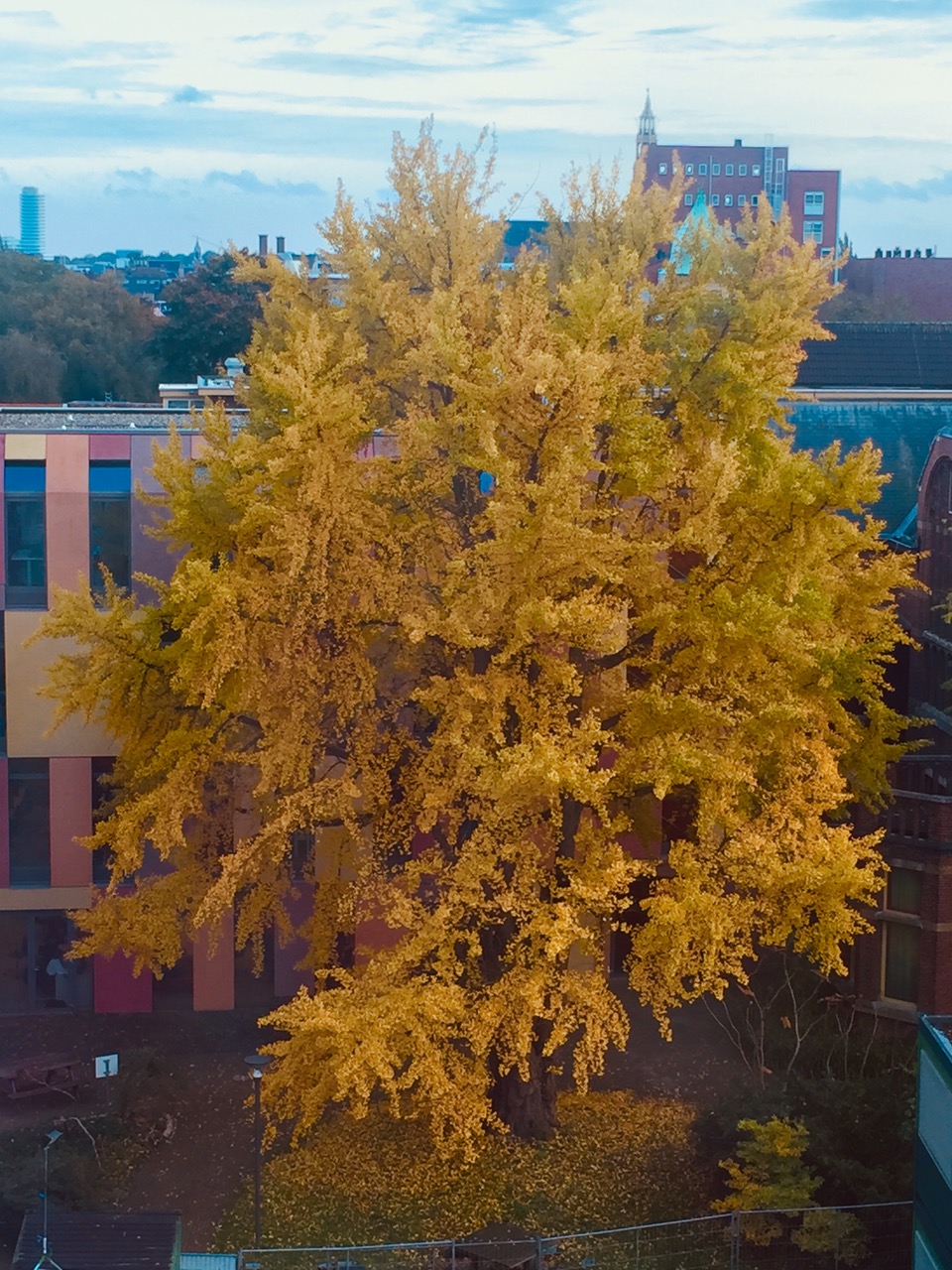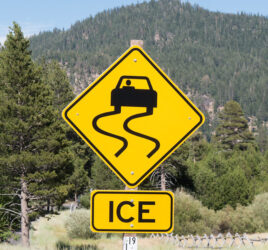
Hope doesn’t fall far from the tree
In the Hortus garden by the Heymans building in Groningen, you can spot a beautiful ginkgo biloba tree; its leaves turn a bright yellow in the fall. But this tree is more than just aesthetically pleasing: The ginkgo biloba symbolizes resilience and hope. It can withstand almost any weather or circumstance, in large part thanks to its deep roots. For example, the story goes that a number of ginkgo biloba trees survived the atomic bombings of Hiroshima (see this blog for more stories about the tree). Additionally, these trees have survived the dinosaurs and are nicknamed ‘living fossils’, as a single tree can live thousands of years. On a personal level, this tree often inspired hope in me as it was the view from the office where I wrote my PhD dissertation on, you guessed it: hope.
Hope and health in the Groningen gas extraction context
Withstanding adversity and maintaining hope are concepts that initially inspired my dissertation. Together with my supervisors (Tom Postmes and Katherine Stroebe) I researched the relationship between hope and health in the context of Groningen gas extraction, earthquakes, and damage. First, we find that hope and health impact each other over time, meaning that experiencing disease may cause a loss of hope, but also that a loss of hope may cause a rise in stress symptoms. This last effect is especially true among people who face more damages to their homes due to earthquakes. In other words: especially for those dealing with adversity, maintaining feelings of hope is beneficial to health. So indeed, the tree remaining healthy after withstanding adversity is thus an appropriate symbol for hope. Furthermore, we find that people can distinguish hope specific to adversity from a more general sense of hope in life, not specified towards a certain domain or certain adversity. Distinguishing between such aspects of hope can be beneficial, because we find that maintaining general hope, even when losing hope specific to adversity, is beneficial to health.
The two-lobed nature of hope
However, this is not where the comparison between the tree and the findings in my dissertation stops. ‘Biloba’ means, freely translated, ‘two-lobed’, referring to the shape of the leaves. This ‘duality’ of the shape of the leaf has inspired many artists throughout history. For example, Goethe (1819) wrote a beautiful poem about the leaves, which contains the following strophe [1]:
Goethe (1819) wrote a beautiful poem about the leaves, which contains the following strophe [1]:
“Is it one living being,
Which has separated in itself?
Or are these two, who chose
To be recognized as one?”
Just like the leaves of the ginkgo biloba, I find that hope contains a duality, where two perspectives can be differentiated within one concept of hope. Because while we know that experiencing hope in adversity is beneficial, it can also be a sign that a person’s situation is hopeless. Additionally, we see that hope can be used to discuss dark and desperate thoughts and intentions. For example, a participant in one of our studies said: “I don’t expect the big earthquake to happen as soon as tomorrow, but if it does happen, I hope it kills me at once”.
Hope is therefore not always a positive signal, as the presence of hope indicates that the person may find themselves in a hopeless and powerless situation. It may indicate that a person is using psychological means to avoid falling into despair. The ‘two-lobed’ nature of hope may then be described as such: When there is hope, it may indicate that there is despair, and when there is despair, it is important to maintain hope.
“Sometimes, hope indicates that a person is using psychological means to avoid falling into despair.”
Hope requires flexibility
Admittedly, there is one point where I think the analogy between the ginkgo biloba and my perspective on hope falls short. The tree represents hope because in a way, it represents changelessness. But hope is not only about the resistance to changing for the worse when under duress. It is also about the ability to adapt to prolonged adversity. It can be about the ability to be flexible in what is hoped for. For example, hope may be thrive when what is hoped for changes (e.g., in situations of incurable disease, it may change from hope for a cure to hope for a dignified death) rather than remaining fixed on one specific positive but unattainable outcome (in this case, hoping for a cure when there is none) (cf., Eliott & Olver, 2002). Paradoxically, the most ‘hopeful’ thing to do may sometimes even be to let go of hope when it “prolongs torments” or causes a vicious circle of expectation and disappointment. The ‘changelessness’ of the tree is thus not always an appropriate metaphor for hope, as hope often calls for change.
“The most ‘hopeful’ thing to do may sometimes even be to let go of hope when it “prolongs torments” or causes a vicious circle of expectation and disappointment.”
The cover of my dissertation represents some of the points I cover in this blog post. It has day and night, representing duality, inspired by Spurgeon (1859): “And dost thou not know that hope itself is like a star — not to be seen in the sunshine of prosperity, and only to be discovered in the night of adversity?” Further illustrating the possible negative side of hope, it has Pandora’s jar (better known as Pandora’s box, but this is most likely a mistranslation) hidden away in the dark. According to the myth, when Pandora’s jar was opened, all evils escaped into the world, but one thing remained inside the jar: hope. This begs the question whether hope was one of the evils, or a divine gift to be able to deal with evils. Nietzsche’s explanation of this myth suggests that “hope in reality is the worst of all evils because it prolongs the torments of man” (1878). To illustrate the context of my research, the cover has a damaged wall representing too many walls damaged by earthquakes in Groningen. And of course, it has the ginkgo biloba tree: a personal inspiration and a symbol of hope.
Notes
[1] Translation from German to English by an anonymous Wikipedia contributor
[2] Image of Ginkgo tree by Babet Kanis from her office window. Gingko leaves by Yvonne Groen.
References
Eliott, J. A., & Olver, I. N. (2002). The discursive properties of ‘hope’: A qualitative analysis of cancer patients’ speech. Qualitative health research, 12(2), 173-193.
Kanis, B. (2022). Hope and health in the face of adversity [Doctoral dissertation, University of Groningen].




Thanks. Great post! I’d like to add that adaptation also has two (or more) sides: You can adapt yourself to a situation/environment; you can try to change the situation/environment; or to move somewhere else. I feel sometimes that we as psychologists tend to focus too much on the first.
In our cultural history the famous thought has been repeated over and over again (if you’re already quoting Goethe, Nietzsche, and others), as far as I know since more than 2,000 years: Give me the strength to change what I can change, to accept that which I cannot change, and the wisdom to distinguish between the two.
Mr. Schleim, you’re quoting the so-called Serenity Prayer, please see https://en.wikipedia.org/wiki/Serenity_Prayer.
This has been attributed to all kinds of people, but it’s not as old as you say. I believe its widespread use comes from the adoption of the prayer by Alcoholics Anonymous in the US. From there, it may have moved on to the “positive thinking” and “mindfullness” entrepeneurs that have multiplied so abundantly in Western society.
Ms. Kanis, could it be that hope, als all things in this universe, only becomes this binary equation of “evil” versus “blessing” when mankind chooses to treat it as such? A construct of the mind in the endless effort to make sense of it all? And if so, would it help to acknowledge hope, and just say: “Ah, there is hope. Hi hope” and attach no meaning to it, either good or bad? Perhaps in attaching meaning, expectations arise, and we all know that expectations, either good or bad, can cloud our view of what *is*.